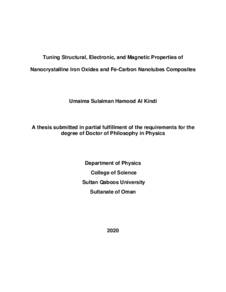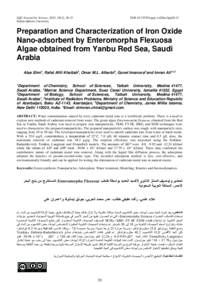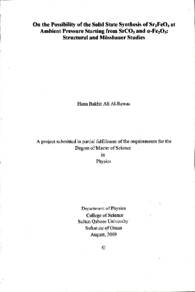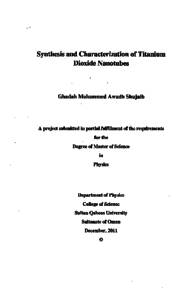Document
Tuning structural, electronic, and magnetic properties of nanocrystalline iron oxides and Fe-carbon nanotubes composites.
Publisher
Sultan Qaboos University.
Gregorian
2020
Language
English
English abstract
Modification of magnetic ferrite nanoparticles (NPs) could open new avenues
for their applications in many fields. SnxFe3-2x/3O4 NPs were synthesized using
precipitation under reflux by Sn2+ doping (x = 0.000-0.150) and characterized using a
host of morphological, structural, magnetic, and surface characterization techniques.
Sn2+ doping increases the NPs-size (12-50 nm) and protects them from oxidation and
transformation to the -Fe2O3 phase, thus making them more suitable for many
applications. From Rietveld refinement data, dopant Sn2+ ions, while preferentially
occupying the B sites at equilibrium, initially started with A site occupation. The
randomly-oriented spins on the surface of these nanoparticles, together with oxidation
to maghemite, explain the observed decrease in magnetization for Fe3O4 nanoparticles,
but not for the doped samples, where spin canting in B sites was preferred. In addition,
an unusual and new magnetic feature was found after high-temperature annealing of
these NPs. Detailed characterizations during the heating-cooling cycles revealed the
possibility of tuning the unusual observed magnetization dipping
temperature/amplitude, irreversibility, and Curie point of these NPs by doping with
Sn2+. A phenomenological expression that combines both modified Bloch law and a
modified Curie–Weiss law was developed to explain the observed M-T behaviors.
Additionally, hydrothermally-synthesized needle-shaped Sn2+ doped uncoated
and C-coated α-Fe2O3 nanorods (NRs) (Sn2+ % of 0, 1.5, 3, and 5%) were observed to
be destroyed in shape by Sn2+ doping. By calcination (600 C), the shape of the
nanorods is retained. The magnetic study (at a temperatures range of 2-900 K, and
fields from 10 to 200 Oe,showed field-dependent magnetization at the same warming–
cooling rates, thermal hysteresis (15-30 K) of the Morin temperature, and Sn2+
dependent susceptibility. In this study, we explain the suppression of the Morin
transition for nanosized particles with c/a of 2.74.
Furthermore, the evaporation technique was used to synthesis iron-based
nanoclusters (NCs) and make an iron-coating layer, on MWCNTs and Si substrates.
The Fe/MWCNTs NCs were found to be large, forming a core/shell structure. An
electron transfer between NCs and MWCNTs was evident. A shift in the binding
energy of XPS core ionization levels and the valence band maximum (VBM) were
observed, confirming the formation of a semi-metallic phase. The saturation
magnetization increased five times in clustering, compared to coating with a noticeable
negative exchange bias in the Fe/Si coated sample.
Member of
Resource URL
Category
Theses and Dissertations




